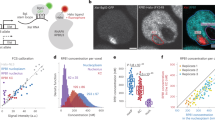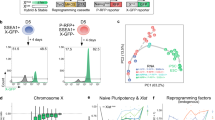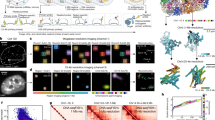Abstract
Template-active regions of chromatin are structurally distinct from nontranscribing segments of the genome. Recently, it was suggested that the conformation of active genes which renders them sensitive to DNase I may be maintained even in fixed mitotic chromosomes. We have developed a technique of mitotic cell fixation and DNase I-directed nick-translation which distinguishes between active and inactive X chromosomes. We report here that Gerbillus gerbillus (rodent) female cells contain easily identified composite X chromosomes each of which includes the original X chromosome flanked by two characteristic autosomal segments. After nick-translation the active X chromosome in each cell is labelled specifically in both the autosomal and X-chromosomal regions. The inactive X chromosome is labelled only in the autosomal regions and in a small early replicating band within the late replicating ‘original X’ chromosome. Our technique opens the possibility of following the kinetics of X-chromosome inactivation and reactivation during embryogenesis, studying active genes in the inactive X chromosome and mapping tissue-specific gene clusters.
This is a preview of subscription content, access via your institution
Access options
Subscribe to this journal
Receive 51 print issues and online access
We are sorry, but there is no personal subscription option available for your country.
Buy this article
- Purchase on Springer Link
- Instant access to full article PDF
Prices may be subject to local taxes which are calculated during checkout
Similar content being viewed by others
References
Weintraub, H. & Groundine, M. Science 193, 848–856 (1976).
Bellard, M., Gannon, F. & Chambon, P. Cold Spring Harb. Symp. quant. Biol. 42, 729–791 (1977).
Gottesfeld, J. & Partington, G. Cell 12, 953–962 (1977).
Garel, A. & Axel, R. Proc. natn. Acad. Sci. U.S.A. 73, 3966–3970 (1976).
Panet, A. & Cedar, H. Cell 11, 933–940 (1977).
Garel, A., Zolan, M. & Axel, R. Proc. natn. Acad. Sci. U.S.A. 74, 4867–4871 (1977).
Stalder, J., Groundine, M., Dodgson, J.B., Engel, J.D. & Weintraub, H. Cell 19, 973–980 (1980).
Gazit, B., Cedar, H., Lehrer, I. & Voss, R. Science 217, 648–650 (1982).
Wahrman, J., Richler, C., Neufeld, E. & Friedmann, A. Cytogenet. Cell Genet. 35, 161–181 (1983).
Zakharov, A. F. & Egolina, N. A. Chromosoma 38, 341–365 (1972).
Latt, S. A. Proc. natn. Acad. Sci. U.S.A. 70, 3395–3399 (1973).
Sarto, G. E., Therman, E. & Patau,, K. Clin. Genet. 6, 289–293 (1974).
McKusick, V. A. & Chase, G. A. A. Rev. Genet. 7, 435–473 (1973).
Shapiro, L. J., Mohandas, T., Weiss, R. & Romeo, G. Science 204, 1224–1226 (1979).
Müller, C. R., Westerveld, A., Beate Migl, B., Franke, W. & Roppers, H. H. Hum. Genet. 54, 201–204 (1980).
Willard, H. F. & Latt, S. A. Am. J. hum. Genet. 28, 213–227 (1976).
Therman, E., Sarto, G.E., Distèche, C. & Denniston, C. Chromosoma 59, 137–145 (1976).
Author information
Authors and Affiliations
Rights and permissions
About this article
Cite this article
Kerem, BS., Goitein, R., Richler, C. et al. In situ nick-translation distinguishes between active and inactive X chromosomes. Nature 304, 88–90 (1983). https://doi.org/10.1038/304088a0
Received:
Accepted:
Published:
Issue Date:
DOI: https://doi.org/10.1038/304088a0
This article is cited by
-
A unique late-replicating XY to autosome translocation in Peromyscus melanophrys
Chromosome Research (2010)
-
New approaches to in situ detection of nucleic acids
Histochemistry and Cell Biology (1995)
-
The distribution of genes on chromosomes: A cytological approach
Journal of Molecular Evolution (1993)
-
Analysis of DNase 1 sensitivity and methylation of active and inactive X chromosomes of kangaroos (Macropus robustus) by in situ nick translation
Chromosoma (1993)
-
DNA methylation of sex chromosomes in a dioecious plant, Melandrium album
Molecular and General Genetics MGG (1993)
Comments
By submitting a comment you agree to abide by our Terms and Community Guidelines. If you find something abusive or that does not comply with our terms or guidelines please flag it as inappropriate.



